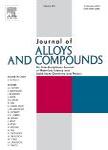版权所有:内蒙古大学图书馆 技术提供:维普资讯• 智图
内蒙古自治区呼和浩特市赛罕区大学西街235号 邮编: 010021

作者机构:South China Univ Technol Sch Mat Sci & Engn Guangzhou 510640 Peoples R China Univ Grenoble Alpes Grenoble INP Inst Neel F-38000 Grenoble France South China Univ Technol Gent Mat Surface Technol Guangdong Co Ltd Zhongshan R&D Ctr Mat Surface & Thin Films Technol Zhongshan 528437 Peoples R China South China Normal Univ Inst Adv Mat South China Acad Adv Optoelect Guangzhou 510006 Peoples R China Harbin Inst Technol Shenzhen Sch Sci Guangdong Prov Key Lab Semicond Optoelect Mat & Intelligent Photon Syst Shenzhen 518055 Peoples R China Chinese Acad Sci Ningbo Inst Mat Technol & Engn Lab Rare Earth Magnet Funct Mat Ningbo 315201 Peoples R China Univ Texas Arlington Dept Phys Arlington TX 76019 USA
出 版 物:《JOURNAL OF ALLOYS AND COMPOUNDS》 (J Alloys Compd)
年 卷 期:2025年第1010卷
核心收录:
学科分类:080603[工学-有色金属冶金] 0806[工学-冶金工程] 08[工学] 0805[工学-材料科学与工程(可授工学、理学学位)] 0703[理学-化学]
基 金:National Key R&D Program of China [2022YFB3505700] Natural Science Foundation of Guangdong Prov-ince [2024A1515030178, 2020A1515010736, 2021A1515010451] Science and Technology Project of Guangdong Province [2023A0505050145] Guangzhou Municipal Science and Technology Program Fundamental Research Funds for the Central Universities [2023ZYGXZR091] Zhongshan Collaborative Innovation Fund [2018C1001]
主 题:SmCo-based films Magnetic coercivity Microstructure evolution Magnetron sputtering Micromagnetic simulation
摘 要:Permanent magnetic thick films are increasingly used in Micro-Electro-Mechanical Systems (MEMS) devices, but the interplay between magnetic properties, microstructure, and film thickness remains underexplored. We deposited SmCo-based films with thicknesses ranging from 350 nm to 1300 nm using magnetron sputtering at room temperature, followed by in-situ annealing. Our study examined the evolution of microstructure, phase composition, magnetic properties, and domain structures as thickness increases. The films displayed dense, fibrous structures typical of the zone T-type region, with 3D morphologies forming a network structure and an arc-shaped surface that expands with thickness. At thinner levels (around 350 nm), an amorphous SmCo phase predominates, prone to oxidation, while at greater thicknesses, the SmCo5 phase dominates but maintains a grain size of 12-15 nm. Coercivity decreases significantly from 33 kOe to 8 kOe as thickness increases from 630 to 1300 nm due to the diminishing pinning effect and dominance of the reversal domain nucleation mechanism. Analysis using magnetic force microscopy and micromagnetic simulations indicates that this reduction in coercivity is mainly due to the decomposition of the SmCo5 phase and a reduction in magnetic domain size.